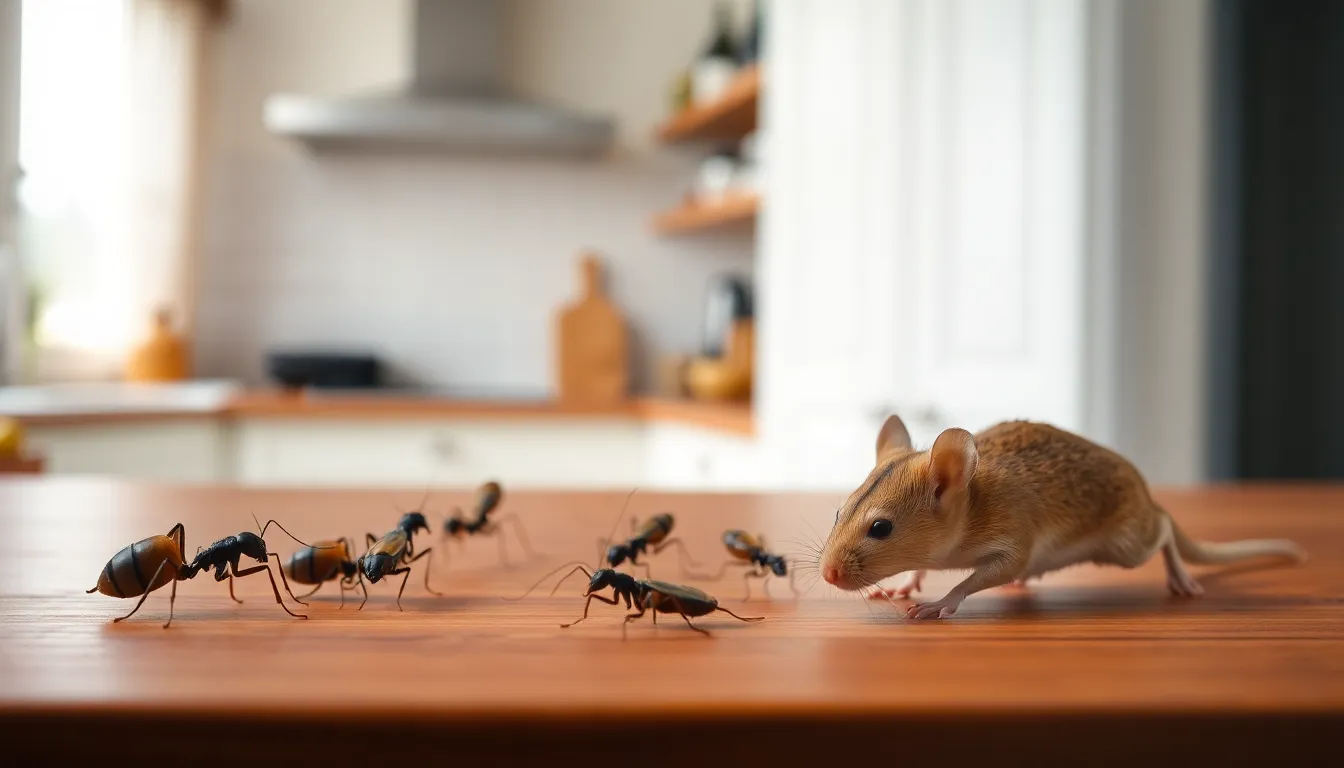Table of Contents
TogglePests can turn any cozy home into a chaotic battleground. From sneaky ants marching across the kitchen counter to mice hosting late-night parties in the pantry, these uninvited guests know how to crash the party. But fear not! Pest control is here to save the day, armed with strategies and solutions that’ll send those critters packing.
Overview of Pest Control
Pest control comprises methods and strategies to manage unwanted organisms that threaten health and property. This field addresses various pests, including insects, rodents, and other animals that infest homes and buildings. Professionals in pest control utilize a combination of preventive measures, monitoring techniques, and targeted treatments.
Prevention plays a vital role in pest control. Keeping homes clean, sealing entry points, and managing food storage reduce the risk of infestations. Regular maintenance of yards and gardens further minimizes habitats for pests.
Monitoring for pest activity enhances control efforts. Using traps and visual inspections helps identify early signs of invasions. This proactive approach enables quicker response to emerging problems.
Treatment options vary based on the type of pest. Chemical treatments, including insecticides and rodenticides, offer immediate results. Integrated pest management (IPM) incorporates biological controls and habitat manipulation alongside chemical solutions. This holistic approach promotes environmental safety while effectively managing pest populations.
Regulations govern pest control practices. Compliance with federal and local regulations ensures safe pesticide applications. Understanding these laws fosters responsible pest management while protecting public health and the ecosystem.
Pest control services range from DIY solutions to professional interventions. Homeowners often seek expert assistance for severe infestations. Certified pest control technicians assess situations and tailor solutions to specific needs.
Ongoing education about pest behavior aids homeowners in maintaining pest-free environments. Adding knowledge about seasons and pest life cycles allows for timely interventions. Staying informed promotes effective prevention and response strategies.
Types of Pests

Various types of pests affect homes and agriculture. Understanding these pests helps in implementing effective control measures.
Common Household Pests
Common household pests include ants, roaches, and rodents. Ants often invade kitchens in search of food, while roaches thrive in dark, damp areas. Mice frequently enter homes seeking warmth and food, causing damage and spreading diseases. Termites pose a significant threat to wooden structures, and bed bugs create discomfort by feeding on human blood. Each pest requires tailored management strategies to ensure effective elimination.
Agricultural Pests
Agricultural pests significantly impact crop health and yield. Aphids, for instance, attack plants, draining essential nutrients. Moreover, caterpillars consume leaves, leading to reduced plant growth and productivity. Weeds compete with crops for resources, further complicating agricultural management. Fungi and other pathogens also threaten crop viability by causing diseases. Effective pest control methods like crop rotation, biological controls, and integrated pest management are crucial for protecting agricultural outputs.
Pest Control Methods
Pest control involves several effective methods to manage unwanted pests in homes and farms. Understanding these methods ensures homeowners and farmers can choose the best approach for their specific situations.
Chemical Control
Chemical control offers quick solutions for immediate pest problems. Pesticides, including insecticides and rodenticides, target specific pests and provide effective eradication. Safety precautions bring peace of mind, as it’s crucial to follow usage instructions and environmental guidelines. These products often come in sprays, baits, or granules, allowing for flexibility in application. Although chemical options offer swift results, they may pose health risks and impact beneficial organisms.
Biological Control
Biological control introduces natural predators or pathogens to target pests. For example, ladybugs eat aphids while nematodes can control larvae in the soil. This method reduces reliance on synthetic pesticides and promotes ecological balance. Utilizing biological agents can encourage healthier ecosystems, leading to long-term solutions for pest management. Challenges exist, such as ensuring the introduced species thrive in the new environment.
Cultural Control
Cultural control emphasizes preventative practices to minimize pest infestations. Maintaining cleanliness, proper food storage, and routine inspections significantly reduce pest attractants. Planting resistant crop varieties and employing crop rotation techniques further disrupt pest life cycles. This proactive approach fosters an environment less conducive to pest survival. Educating homeowners and farmers on effective cultural practices enhances their ability to manage pests effectively.
Importance of Pest Control
Pest control plays a vital role in maintaining a healthy living environment. Unmanaged pests pose risks to physical health, potentially transmitting diseases and contaminating food sources. Ants, roaches, and rodents each carry specific health threats, emphasizing the necessity of effective pest management strategies.
Property protection stands as another critical reason for pest control. Infestations can lead to structural damage, decreasing property value. Mice, for instance, are known to gnaw through electrical wires, creating fire hazards. Addressing pest issues promptly can prevent extensive repairs and create a safer home.
Effective pest control practices also contribute to mental well-being. The presence of pests can cause anxiety and discomfort among households. Keeping homes pest-free fosters peace of mind, allowing individuals to enjoy their living spaces without fear of unwanted intruders.
Prevention remains essential within pest control strategies. Regular cleaning and sealing entry points significantly reduce opportunities for pests to enter homes. Additionally, effective food storage practices keep potential attractants inaccessible, making properties less inviting to pests.
Monitoring pest activity aids in early detection, which is crucial for successful management. Using traps and conducting inspections helps identify emerging problems promptly. Quick responses to pest activity can mitigate larger infestations, leading to safer environments.
Treatment options differ depending on specific pest challenges. Chemical solutions provide immediate relief, whereas integrated pest management focuses on long-term ecological safety. Understanding the right approach ensures a sustainable and effective pest control strategy.
Finally, knowledge of pest behavior enhances management efforts. Homeowners and farmers benefit from ongoing education about common pests and applicable control methods. This continuous learning facilitates better pest control practices, supporting both household comfort and agricultural productivity.
Effective pest control is essential for maintaining a healthy and comfortable living environment. By implementing preventative measures and understanding pest behavior, homeowners can significantly reduce the risk of infestations. Regular monitoring and tailored management strategies ensure that both household and agricultural pests are kept at bay.
Utilizing a combination of chemical, biological, and cultural controls allows for a balanced approach to pest management. Ongoing education and awareness about pest activity empower individuals to respond swiftly to emerging issues. Prioritizing pest control not only protects property but also promotes overall well-being for everyone in the home.




